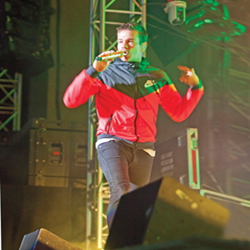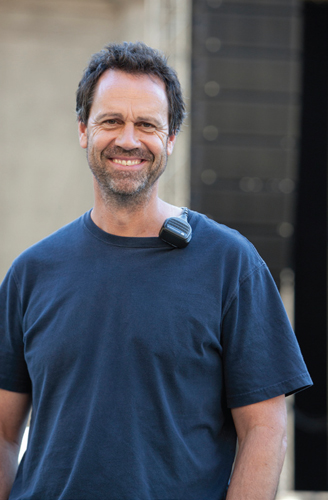
He adds that it can get thunderous with all of that low-frequency energy up front, so the stage lip is “coated” with UPQ-2P and UPQ-1P compact loudspeakers to make sure the audience in the extreme near field is getting something to go with that big serving of sub bass.
While the size of the rig varies venue to venue, Reddy prefers to use as many loudspeakers as possible every gig.
“Not because I want to melt everybody, it’s just more consistent – more direct and less reflected energy,” he explains. “The more hanging there in terms of width and length allows you to be really specific about how you deliver that power, to make it pleasant up close while being convincing farther back. More like climbing into a set of headphones rather than listening to it off the barn wall.”
The drive system for the loudspeakers, which are all self-powered, incorporates dual Meyer Sound Galileo 616 loudspeaker management processors for alignment of multiple zones, feeding (via AES outpus) three Meyer Sound Callisto 616 array processors that provide delay integration for aligning the arrays, shaping filters, and simultaneous low- and high-pass filters for subwoofer control.
Accompanying Compass control software provides comprehensive control of all parameters from a Mac or Windows-based computer. “I use Galileo to make ‘broad strokes’ for the whole system, and then for zone-specific treatment, which I keep to an absolute minimum, I go to Callisto,” Reddy explains.
“With this loudspeaker rig – or without it – Galileo is my drive device for system EQ,” he continues. “If we’re playing a festival and they’ve got subs on an auxiliary – which is very common – when they hand me the separate wire, I drive it through my Galileo and stitch the subwoofers back into the rest of that 10-octave composite of musical information the way it should be. Galileo allows me to do that outside the mix environment.”
Good Is Good
I followed up by asking Reddy if he applies any specific treatment for Fun and received a spirited response. “You’re opening up a big can of worms for me,” he states. “Sound systems aren’t super-conceptual. I don’t care what style of music you’re spraying out of them – good power tuning is good power tuning, good directivity is good directivity, good direct-to-reflected ratios are good direct-to-reflected ratios. These do not and should not have anything to do with the artist.
“We owe it to ourselves, the industry, and the audience to understand how the manufacturers intended this stuff to be used. The popularized mythology says that editing crossover settings is good, but it’s the equivalent of taking the front wheels of your car out of alignment and saying, ‘When I drive on this kind of surface I like my camber angle to be out a bit.’ It never made sense and I’ll go to my grave fighting anybody who says otherwise. I’ve got two pages in my rider covering no ‘home-proved’ drive settings, please. Keep your settings away from me. Give me the ones the manufacturer developed.”
The stage is relatively quiet, devoid of monitor wedges and side fills. Band principals Nate Ruess (lead vocals), Andrew Dost (piano) and Jack Antonoff (lead guitar)—along with their touring mates Nate Harold (bass), Emily Moore (keyboards) and Will Noon (drums) – wear either Ultimate Ears or JH Audio custom in-ear monitors, fed by Shure PSM 1000 personal monitoring systems, notes Phoenix-based monitor engineer Dave Rupsch, who joined the Fun crew in January of this year.


